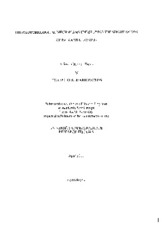The neurobiological mechanisms underlying the sensitization of pain and learning
Abstract
Why animals learn and how they do so has long been a topic of inquiry and research. Recently, King, Joynes, Meagher and Grau (1996) showed that exposure to a mild aversive event (a brief shock) can enhance both learning and pain. My thesis explored the neural mechanisms that underlie this effect. Prior research suggested that the septum may play a role in both pain and learning, but the relationship between these two phenomena had not been defined. My hypothesis was that exposure to an aversive event may impair the activity of the septum and thereby enhance stimulus processing. This in turn could increase the painfulness of subsequent aversive stimuli (hyperalgesia) and facilitate learning. If my hypothesis is correct, then pharmacologically inducing a state of arousal (by injecting scopolamine, an acetylcholine antagonist) should sensitize both pain and learning. As predicted, Experiment 1 showed that scopolamine induces hyperalgesia in a dose-dependant fashion. Experiment 2 examined the drug's effect on learning using a Pavlovian conditioning procedure. If scopolamine enhanced the painfulness of the aversive unconditioned stimulus, then it should also augment learning. The data show a trend to the non-monotonic function described by Fanselow et al (1994), and can be explained with their explanation of a behavioral systems approach. My data suggest that acetylcholine is indeed playing a role in hyperalgesia and enhanced learning, although more research is needed to further clarify this role.
Description
Due to the character of the original source materials and the nature of batch digitization, quality control issues may be present in this document. Please report any quality issues you encounter to digital@library.tamu.edu, referencing the URI of the item.Includes bibliographical references (leaves 21-22).
Citation
Patton, Brianne Colemarie (2001). The neurobiological mechanisms underlying the sensitization of pain and learning. Texas A&M University. Available electronically from https : / /hdl .handle .net /1969 .1 /ETD -TAMU -2001 -Fellows -Thesis -P3682.


